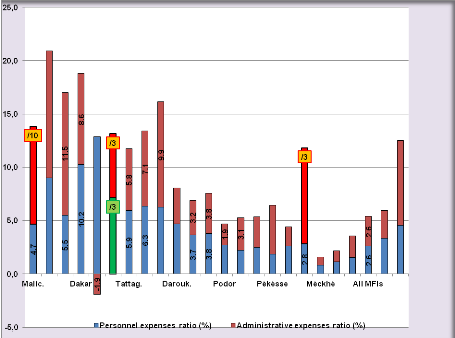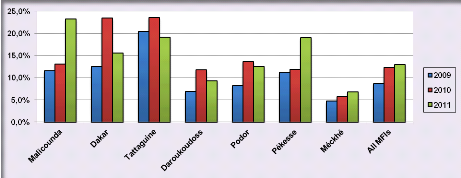5.1.2 Efficiency
5.1.2.1 Sound controlled operating expenses ratio
Operating expenses ratio appears as on major indicator to
assess whether MFIs are cost effective and expresses all the operating expenses
as a percentage of the period average gross loan portfolio (Rosenberg, 2009).
The figure 9 shows up the evolution of operating expenses ratio of the MFIs
over the last three years.
Figure 9: Operating
Expenses Ratios 2009-2011

/X: The real value is X times de value on the
figure
Source: Our survey (may-august
2012)
The figure brings out that in more than 85% of the cases,
operating expenses ratios are below 20%. However, the MEC MFR of Malicounda
recorded the highest operating expenses ratio of more than 95% in 2009 but
significant improvements are made in 2010 and 2011.
In opposite, the MEC of Dakar recorded the highest operating
expenses ratio in 2011 of about 40% after sound improvement in 2010. The
negative administrative expenses ratio in 2010 (-1.9%) is due to the recovery
in depreciation expenses.
The CREC of Meckhé recorded the lowest operating
expenses ratio subsequent to its high average loan size.
If for Lafoucarde et al. (2005) operating and
financial expenses are high in African regions, the specific case of this study
might be due to the fact that MFIs hire fewer and underpaid staff, use a very
simple accounting system, sometimes without any Management Information System
with low administrative expenses. For example, the use of paid internship
positions at the MEC of Tattaguine, and the opening of periodic services points
along with additional remunerated interns increased the operational expenses in
2011. The same trend is observed at the MEC FAM of Dakar where they permanently
hire internship positions in addition to old staff.
The analysis of the breakdown of operation expenses ratio
reveals that the most important part of operating expenses is pertained to
administrative costs.
However, opposite situation is observed at the MEC of Dakar
where personnel expenses are higher than administrative expenses over time.
This might be explained by higher staff salaries in urban areas compared with
MFIs operating in rural areas.
5.1.1.2 Portfolio Yield
The portfolio yield conveys how much an MFI earns in cash
interest payment from its credit provision in a given period. It is perceived
as a foremost indicator of an MFI's ability to create revenue in order to
defray its financial and operating expenses (von Stauffenberg et al.,
2003).
The figure 10 shows the evolution of the portfolio yield
during the last three years
Figure 10: Portfolio yields
2009-2011

Source: Our survey (may-august
2012)
The analysis reveals that the MEC MFR of Malicounda recorded
an increase in its portfolio yield during the last three years from about 11%
to 23%.
Kindred growth trends are observed with the MEC MFR of
Pékésse (11-19%) and the CREC of Méckhé (5-7%).
Notwithstanding that the CREC of Meckhé recorded an
increase in portfolio yield, the latter remains the lowest of the group due to
its low interest rate policy combined with the absence of additional fees
linked to the loan granting process. In contrast, the highest portfolio yields
recorded by the MEC of Tattaguine, Dakar and Pékesse (particularly in
2011) are due to the high rate and other additional fees and commissions on the
loan.
For the other MFIs, no real trend can be concluded even though
they recorded also important yield of their portfolios.
The differences reported in portfolio yields could be due to
additional fees, the differences in interest rates each MFI applies, even
though they have nearly loan products. For instance, the MFI of
Méckhé does not apply a fee for loan processing and charge a low
interest rate for investment loans (12) versus 1% for the MEC of Pékesse
with an interest rate of about 15% charged on investment loans. That
variability in loan product is due to the fact that each loan product is
tailored for each MFI in line with the expectations of their members,
expectation clearly stated during annual general meetings.
As the portfolio yield can be used as a proxy of effective
interest rate, it appears that the MFIs of Malicounda, Tattaguine, Dakar and
Pékésse apply the highest effective interest rates, which are
however below the usury rate in the UMOA region (27%). On the other hand, an
excessive social vision could lead to the application of very low interest
rates threatening the viability of the institution (Ben Soltane, 2012).
| 

